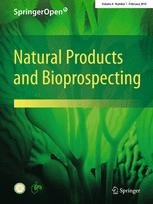|
|
Acetylcholinesterase and Cytotoxic Activity of Chemical Constituents of Clutia lanceolata Leaves and its Molecular Docking Study
Collect
Mehtab Parveen, Faheem Ahmad, Ali Mohammed Malla, Shaista Azaz, Mahboob Alam, Omer A. Basudan, Manuela Ramos Silva, Pedro S. Pereira Silva
Natural Products and Bioprospecting. 2016, 6 (6): 267-278.
DOI: 10.1007/s13659-016-0110-x
Phytochemical investigations of the ethanolic extract of leaves of Clutia lanceolata (Family:Euphorbiaceae) resulted in the isolation of four compounds viz. 3,4-dihydroxy-2-methylbenzoic acid (1), 2,2'-dihydroxy-1,1'-binaphthyl (2), 1,3,8-trihydroxy-6-methylanthracene-9,10-dione (3) and 5-hydroxy-1,7-bis(4-hydroxy-3-methoxyphenyl)hepta-1,4,6-trien-3-one (4). Although all the isolated compounds were known but this was the first report from this plant source. Their structures were established on the basis of chemical and physical evidences viz. elemental analysis, FT-IR, 1H-NMR, 13CNMR and mass spectral analysis. Structure of compound 2 and 4 was further authenticated by single-crystal X-ray analysis and density functional theory calculations. The isolated compounds (1-4) were screened for AChE enzyme inhibition assay in which compound 3 and 4 were found to be more potent AChE inhibitor. Molecular docking study of potent AChE inhibitor was performed to find the probable binding mode of the compounds into the active site of receptor. Moreover, the isolated compounds were also screened for in vivo cytotoxicity by brine shrimp lethality assay.
References |
Related Articles |
Metrics
|
|
|
Lyconadins G and H, Two Rare Lyconadin-Type Lycopodium Alkaloids from Lycopodium complanatum
Collect
Jin-Tang Cheng, Zhi-Jun Zhang, Xiao-Nian Li, Li-Yan Peng, Huai-Rong Luo, Xing-De Wu, Qin-Shi Zhao
Natural Products and Bioprospecting. 2016, 6 (6): 279-284.
DOI: 10.1007/s13659-016-0111-9
Two rare lyconadin-type Lycopodium alkaloids, lyconadins G (1) and H (2), together with four known ones (3-6), were isolated from Lycopodium complanatum. The structures were determined on the basis of their spectroscopic analyses, and the absolute configuration of 1 was established by an X-ray crystallographic analysis. It is the first time to establish the absolute configuration of lyconadin-type Lycopodium alkaloid by an X-ray diffraction experiment. In addition, these findings may provide more information for the biosynthesis of lyconadins.
References |
Related Articles |
Metrics
|
|
|
Indole Glycosides from Aqueous Fraction of Strychnos nitida
Collect
Bei Wang, Zhi Dai, Lu Liu, Xin Wei, Pei-Feng Zhu, Hao-Fei Yu, Ya-Ping Liu, Xiao-Dong Luo
Natural Products and Bioprospecting. 2016, 6 (6): 285-290.
DOI: 10.1007/s13659-016-0112-8
Three new indole glycosides 22-deoxystrictosamide (1), 22-deoxystrictosamide Nb-oxide (2) and vincosamide 2'-O-β-D-xylopyranoside-11-O-β-D-glucopyranoside (3), together with four known analogues were isolated from aqueous fraction of Strychnos nitida. Their structures were elucidated on the basis of extensive analysis of spectroscopic data. All the alkaloids were tested for their cytotoxic activity, but they did not show any exciting result.
References |
Related Articles |
Metrics
|
|
|
(-)-Evodiakine, A Pair of Rearranged Rutaecarpine-Type Alkaloids From Evodia rutaecarpa
Collect
Yan-Hong Li, Yu Zhang, Li-Yan Peng, Xiao-Nian Li, Qin-Shi Zhao, Rong-Tao Li, Xing-De Wu
Natural Products and Bioprospecting. 2016, 6 (6): 291-296.
DOI: 10.1007/s13659-016-0113-7
(±)-Evodiakine (1a and 1b), a pair of rearranged rutaecarpine-type alkaloids with an unprecedented 6/5/5/7/6 ring system, were isolated from the nearly ripe fruits of Evodia rutaecarpa. Separation of the enantiomers have been achieved by chiral HPLC column. The structures of (±)-evodiakine were unambiguously elucidated by 1D and 2D NMR spectra, mass spectrometry, and single-crystal X-ray diffraction. Their absolute configurations were determined by comparison of experimental and calculated electronic circular dichroism spectra. A hypothetical biogenetic pathway for (±)-evodiakine was also proposed. Compounds 1a, 1b, and the racemate (1) were tested for their cytotoxic and anti-inflammatory activities.
References |
Related Articles |
Metrics
|
|
|
A Fragmentation Study on Four Unusual Secoiridoid Trimers, Swerilactones H-K, by Electrospray Tandem Mass Spectrometry
Collect
Chang-An Geng, Ji-Jun Chen
Natural Products and Bioprospecting. 2016, 6 (6): 297-303.
DOI: 10.1007/s13659-016-0114-6
Swerilactones H-K (1-4) as four unprecedented secoiridoid trimers represent a new type of natural product, which has attracted much interest of natural chemists due to their novel skeletons and promising bioactivity. In order to well understand their MS fragmentation behaviors, they were investigated by electrospray ionization ion-trap time-of-flight multistage product ion mass spectrometry (ESI-IT-TOF-MSn) for the first time. The protonated molecules ([M+H]+) of swerilactones J and K, and deprotonated molecules ([M-H]-) of swerilactones H, J and K were readily observed in the conventional single-stage mass spectra (MS); however only the[M+Cl]-ion for swerilactone I was obtained in negative mode. Based on the MSn study, the fragmentation pathways of swerilactones H and I in negative mode, and swerilactones J and K in both positive and negative modes were proposed. The neutral losses of H2O, CO, CO2 and C2H4O moieties are the particular elimination from the precursor ions due to the presence of hydroxyl, δ-lactone and 1-O-ethyl moieties in their structures, of which the retro-Diels-Alder cleavage was the most particular dissociation. The fragment ions at m/z 341 and 291 in negative mode can be considered as the diagnostic ions for secoiridoid trimers. This investigation will provide valuable information for their fast characterization from complicated natural mixtures and extensive understanding their structural architectures.
References |
Related Articles |
Metrics
|
|

